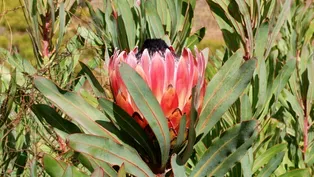
Growing and Eating Artichokes
Clip: 6/30/2023 | 4m 56sVideo has Closed Captions
Artichoke farmers reveal why you shouldn’t be intimidated by this thorny crop.
Artichoke farmers reveal why you shouldn’t be intimidated by this thorny but delicious crop. Artichokes may be a popular dish in California – and in fact, were named the Official State Vegetable in 2013 – but they still remain a mystery to many people outside the Golden State. We meet farmers from Ocean Mist who show you how to eat this unique vegetable.
Problems with Closed Captions? Closed Captioning Feedback
Problems with Closed Captions? Closed Captioning Feedback
America's Heartland is presented by your local public television station.
Funding for America’s Heartland is provided by US Soy, Sustainable Agriculture Research and Education, Rural Development Partners, and a Specialty Crop Grant from the California Department of Food and Agriculture.

Growing and Eating Artichokes
Clip: 6/30/2023 | 4m 56sVideo has Closed Captions
Artichoke farmers reveal why you shouldn’t be intimidated by this thorny but delicious crop. Artichokes may be a popular dish in California – and in fact, were named the Official State Vegetable in 2013 – but they still remain a mystery to many people outside the Golden State. We meet farmers from Ocean Mist who show you how to eat this unique vegetable.
Problems with Closed Captions? Closed Captioning Feedback
How to Watch America's Heartland
America's Heartland is available to stream on pbs.org and the free PBS App, available on iPhone, Apple TV, Android TV, Android smartphones, Amazon Fire TV, Amazon Fire Tablet, Roku, Samsung Smart TV, and Vizio.
Providing Support for PBS.org
Learn Moreabout PBS online sponsorship♪♪ [Chris Drew] Artichokes are a staple here in Castroville.
It's what Castroville is known for.
It's what really put Castroville on the map.
Castroville, uh, folks are very proud of the artichoke, and they have a festival that celebrates the artichoke each year and really enlightens people around the globe to what artichokes are and what they mean here, to the state of California.
Nestled along the Monterey Bay coastline, Castroville enjoys a marine layer that keeps it at a moderate temperature year-round, without extreme highs or lows.
99% of the nation's fresh artichokes come from California, with the majority grown right here in Castroville.
[Chris] We're stewards of the land.
We've been in business nearly 100 years growing in California, and we plan to continue that legacy.
Chris Drew is the president and CEO of Ocean Mist Farms.
It was founded in 1924 in Castroville by a group of family farmers.
Among them was Alfred Tottino, whose great-grandson, Glen Alameda, still works at the company today as director of operations.
[Glen] I'm fourth generation now, um, the last one working here on the day-to-day.
But we have a lot of family supporting, um, kind of on different roles.
When I graduated college, my grandfather was still coming in to work six days a week.
He was 90 years old and I couldn't pass up that opportunity, uh, to come work with him every day.
[Chris] Artichokes are fun to eat.
It's one of those vegetables that you can have on your plate and tell a story about.
And that's really what we're driving home is that there isn't a misperception about artichokes.
They're not difficult to eat.
They actually are an entertainment piece and an adventure at the dinner time.
If artichokes are an adventure to eat, they're an adventure to harvest, too.
Workers move surprisingly fast through these fields, seemingly flipping artichokes up into the air.
[Glen] When we're harvesting artichokes, individuals will have a knife kind of right on their index finger, and they're just harvesting strictly what's ready.
So, they're eyeballing it, where it is on the plant, how big it is.
And we're really looking for that artichoke to stem size ratio.
[Chris] We actually have an individual who wears a large backpack on their back, comes in with a knife, and they... they harvest that artichoke or pick that artichoke from the plant, throw it over their shoulder into a bag.
And that's taken off to the edge of the field where it's packed into a carton based on its particular size.
Once a backpack, called a canasta, is full of artichokes, it's offloaded on the side of the field.
Then, they're sorted and packaged, also in the field.
The packing machinery is mobile, moving right alongside the pickers as they both make their way through the large fields of artichokes.
♪♪ Ocean Mist says they have a four hour "cut to cool" policy, meaning the artichokes cut in the fields are quickly transported to a cooling facility.
That's where they'll be chilled to about 34 degrees.
From there, the artichokes head out to grocers in the United States and abroad.
[Chris] The majority of the artichokes generally can be found in metropolitan areas, the larger cities.
We do classify the Midwest as the artichoke dessert.
Now, we're still looking at ways that we can, uh, reach to those folks and convince them that artichokes are a great vegetable to consume for dinner.
Artichokes may be a popular dish in California, and in fact, were named the official state vegetable in 2013.
But they still remain a mystery to many people outside the Golden State.
[Chris] Artichokes are one of those vegetables that sits on the shelf at the retail store, your grocery store, and many don't know what to do with it.
Uh, it almost, at times, can look more like a weapon than something you're ready to sit down and enjoy.
But artichokes are extremely nutritious, they're fun to eat, and anyone that hasn't tried one should get out there and do so.
So, how do you eat an artichoke?
The most common way is to cut off the top and steam it until the leaves easily pull off, about 30 minutes or so.
Then, serve it with a dipping sauce like mayonnaise or melted butter.
You can also grill artichokes or even bake them.
Whatever your method, artichoke growers want you to know one thing- it's easier than you think!
[Glen] I think it can be very intimidating to look at this thorny vegetable here that does not look very inviting until you cook it up, eat it, and realize it was worth the work, and it really wasn't that much to begin with.
Whether you are an artichoke aficionados or a newbie, growers ask one thing- Eat more of California's official vegetable.
[Chris] If you haven't had an artichoke yet, or you're willing to try one, get out there and do so.
Video has Closed Captions
Clip: 6/30/2023 | 3m 54s | Meet Georgia farmers supplying “imperfect” produce to the Atlanta Community Food Bank. (3m 54s)
Caramel Apple Crisp – Farm to Fork with Sharon Profis
Video has Closed Captions
Clip: 6/30/2023 | 5m 25s | Follow along as we cook up a sweet Caramel Apple Crisp. (5m 25s)
Video has Closed Captions
Clip: 6/30/2023 | 5m 45s | Journey up steep terrain in San Diego County to see how farmers grow protea flowers. (5m 45s)
Providing Support for PBS.org
Learn Moreabout PBS online sponsorshipSupport for PBS provided by:
America's Heartland is presented by your local public television station.
Funding for America’s Heartland is provided by US Soy, Sustainable Agriculture Research and Education, Rural Development Partners, and a Specialty Crop Grant from the California Department of Food and Agriculture.














